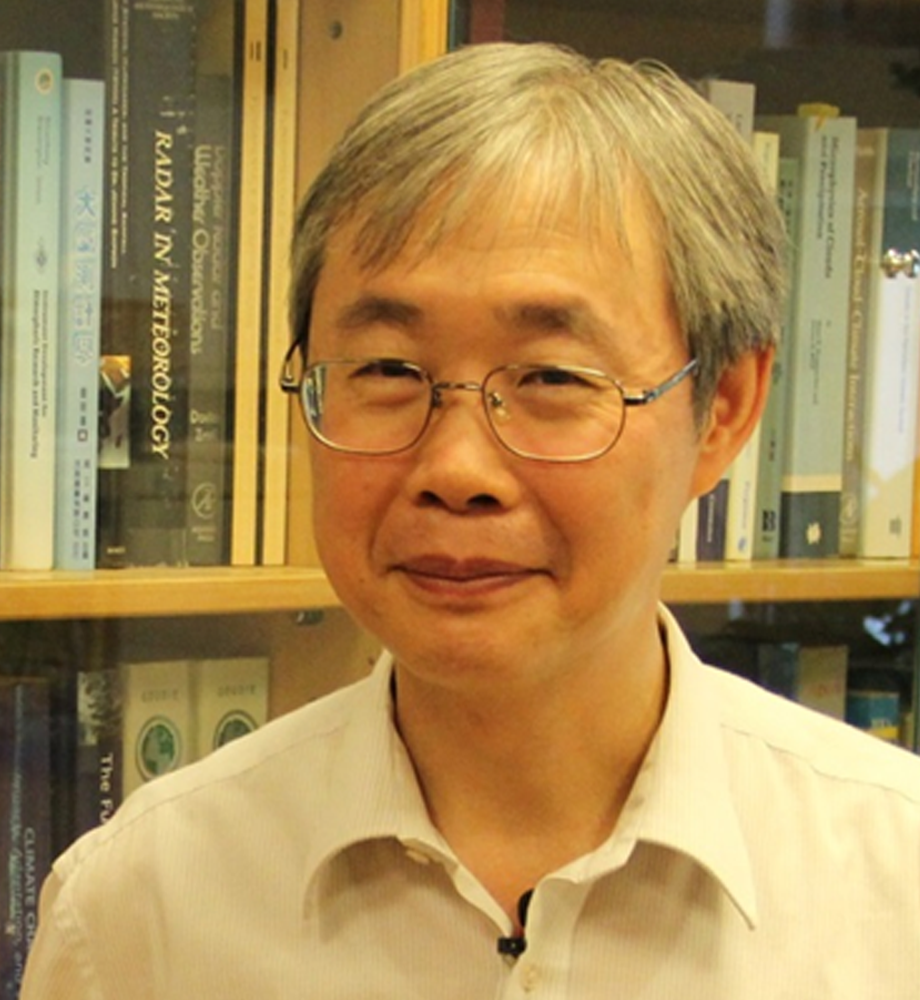

Chen, Jen-Ping陳正平
Joint Appointment Research Fellow
Research Interests
My major research interests include cloud and aerosol microphysics, air pollution, and cloud-aerosol-climate interactions. Main research methodologies include microphysical parameterizations, regional and global numerical modeling, as well as ground and satellite observation data analysis.
Representative Publications
Chen, J.-P., 1994: Theory of deliquescence and modified Köhler curves. J. Atmos. Sci., 51, 3505–3516. https://doi.org/10.1175/1520-0469(1994)051%3C3505:TODAMK%3E2.0.CO;2
Chen, J-.P.*, and D. Lamb, 1994: The theoretical basis for the parameterization of ice crystal habits: Growth by vapor deposition. J. Atmos. Sci., 51, 1206–1221.
Chen, J-.P.*, 1999: Particle nucleation by recondensation in combustion exhausts. Geophys. Res. Lett., 26, 2403–2406. https://doi.org/10.1029/1999GL900510
Chen, J.-P.*, and S.-T. Liu, 2004: Physically-based two-moment bulk-water parameterization for warm cloud microphysics. Q. J. Royal Meteor. Soc., 130, Part A, 51–78. https://doi.org/10.1256/qj.03.41
Chen, J.-P.*, A. Hazra, and Z. Levin, 2008: Parameterizing ice nucleation rates using contact angle and activation energy derived from laboratory data. Atmos. Chem. Phys., 8, 7431–7449. https://doi.org/10.5194/acp-8-7431-2008
Chen, J.-P.*, I-C. Tsai and Y.-C. Lin, 2013: A statistical-numerical aerosol parameterization scheme. Atmos. Chem. Phys., 13, 10483–10504. doi: 10.5194/acpd-13-12033-2013.
Chen, J.-P.*, and T.-C. Tsai, 2016: Triple-moment modal parameterization for the adaptive growth habit of pristine ice crystals. J. Atmos. Sci., 73, 2105–2122. doi:10.1175/JAS-D-15-0220.1
Li, N., J.-P. Chen*, I-C., Tsai, Q. He, S.-Y. Chi, Y.-C. Lin, T.-M. Fu, 2016: Potential impacts of electric vehicle on Taiwan's air quality. Sci. Total Environ., 566-567, 919-928. doi:10.1016/j.scitotenv.2016.05.105
Lin, Y.-C., J.-P. Chen*, T.-Y. Ho and I-C. Tsai, 2015: Atmospheric iron deposition in the Northwestern Pacific Ocean and its adjacent marginal seas: the importance of coal burning. Global Biogeochem. Cycles, 29, 2, 138–159. doi:10.1002/2013GB004795.
Tsai, T.-C., and J.-P. Chen*, 2020: Multi-moment ice bulk microphysics scheme with consideration for particle shape and apparent density. Part I: Methodology and idealized simulation. J. Atmos. Sci., 77, 5, 18211850. https://doi.org/10.1175/JAS-D-19-0125.1
Highlights
Our group started the development of advanced bulk microphysics schemes since the work of Chen and Liu (2004), in which a very detailed bin model was applied to generate a statistically derived double-moment warm-cloud parameterization with high precision and computation efficiency. This CL04 scheme was implemented into the MM5 model (Cheng et al. 2007) and coupled with a double-moment (2M) ice-phase scheme (Cheng et al. 2010). Later, it was coupled into the WRF model and applied to many case studies. The 2M scheme was recently upgraded with a triple-moment (3M) closure method, as well as by adding parameterizations for ice crystals’ shape and density variations (Chen and Tsai 2016; Tsai and Chen 2020) based on the theoretical parameterization that I developed in the past (Chen and Lamb 1994). The NTU 3M scheme (now microphysics option 56 in the WRF model) has detailed treatments for aerosol-cloud interactions, including resolved supersaturation and activation of condensation nuclei, as well as species and size-dependent ice nucleation based on the theoretical parameterization of Chen et al. (2008) and Hoose et al. (2010). This scheme considers the aerosol recycling from cloud drop evaporation, and may also track ice nuclei within the hydrometeor particles to enable full interaction between aerosols and clouds.
In a joining project “Consortium for Climate Change Study,” efforts were devoted to improving cloud schemes in climate models. With the collaborations from C.-J. Shiu and I-C. Tsai, the following major tasks have been accomplished: I. Incorporated the 3M aerosol scheme (Chen et al. 2013) into the NCAR CAM5 global model and the TaiESM model to replace the original 2M scheme. II. Incorporated the NTU 2Mcloud microphysics scheme into CAM5 and TaiESM for stratiform-cloud microphysics. III. Modify the cumulus parameterization scheme in TaiESM to incorporate the NTU 2M warm-cloud scheme and allow in-cloud raindrop sedimentation for better representation of precipitation formation. IV. Develop a new parameterization scheme for fast and accurate diagnoses of cloud drop number concentration at cloud base for enabling aerosol-cloud interactions in global models (Wang and Chen 2019). V. Merging the macrophysics and microphysics in CAM5 for a more consistent representation of cloud processes, with improved treatments in the in-cloud saturation ratio and the WBF process, and better coupling of the activation/nucleation processes.
Interdisciplinary topics recently investigated by our group include the following: I. By simulating the emissions and transport of natural (contained in mineral dust) and anthropogenic (contained in fly ash) iron, we found that industrial activities may contribute more soluble iron into the Northwester Pacific than natural sources (Lin et al. 2015). II. Through parameterization and numerical modeling, we found that rainwater penetrates faster and deeper into the soil via stem-root flow, significantly influencing the land-atmosphere moisture and energy exchange (Kuo et al. 2016). III. The impact of hypothesized nationwide penetration of light-duty electric vehicle (EV) on Taiwan’s air quality was evaluated (Li et al. 2016). The results suggest that net emissions of NOX, VOCs, CO, and PM2.5 would be reduced while that of SO2 increased by introducing EV to Taiwan. Overall, EV penetration would reduce pollution episodes in Taiwan's major cities by up to 60%. IV. Atmospheric water stable isotopes fractionation due to cloud microphysical processes were investigated based on the kinetic mass transfer theory (Tsai et al. 2019). The thermal equilibrium assumption used earlier may cause an overestimate of mean vapor-phase D by 11‰, and the maximum difference can be more than 20‰. Initial vertical distribution, lower boundary conditions, and cloud microphysics fractionation are all critical in determining D.

(02)3366-3912
jpchen@ntu.edu.tw